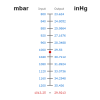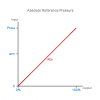When it is necessary to present gauge reference pressure data, an absolute pressure sensor can be used in some situations if a gauge pressure sensor is not available.
An absolute pressure sensor will measure total pressure independent of atmospheric pressure changes, unlike a gauge pressure sensor which measures pressure relative to atmospheric pressure. To convert the absolute reading to a gauge reference type the atmospheric pressure should be subtracted from the total measured pressure.
The same sensor can be used to measure the total pressure and the atmospheric pressure. Since the atmospheric pressure will change over time, the more often it is checked, the more precise will be the conversion to gauge pressure. The overall uncertainty of the gauge pressure conversion will be the sum of both reading errors, which for most sensors is double the full scale error indicated on the product specification data sheet.
If the atmospheric pressure at a particular location rarely exceeds 1 bar abs, an absolute pressure sensor should only be used if it’s pressure range is at least 1 bar higher than the gauge range required. So a 0-2 bar absolute range should only be used to measure 0-1 bar gauge at this example location.
Related Help Guides
- Measuring vacuum as a negative gauge pressure using a dp sensor
- Measuring vacuum with negative gauge or absolute ranges
- What is the difference between gauge and absolute pressure measurement
- What is the difference between vacuum and absolute pressure
- Can you measure vacuum using a gauge pressure range
- What does negative and positive gauge pressure mean
Related Technical Terms
- Gauge Reference Pressure
- MSL – Mean Sea Level
- Negative Gauge Pressure
- Reference Pressure
- SG – Sealed Gauge
- Vented Cable
- Vented Gauge



